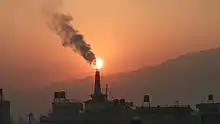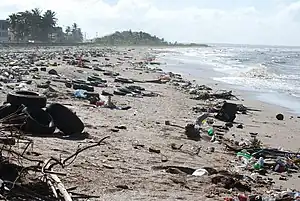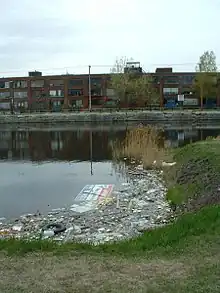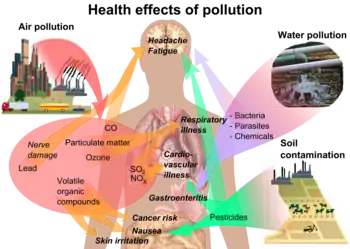Pollution
.png.webp)
| Part of a series on |
| Pollution |
|---|
 |
|
|
Pollution is the introduction of contaminants into the natural environment that cause adverse change.[1] Pollution can take the form of any substance (solid, liquid, or gas) or energy (such as radioactivity, heat, sound, or light). Pollutants, the components of pollution, can be either foreign substances/energies or naturally occurring contaminants. Although environmental pollution can be caused by natural events, the word pollution generally implies that the contaminants have an anthropogenic source – that is, a source created by human activities. Pollution is often classed as point source or nonpoint source pollution. In 2015, pollution killed nine million people worldwide (one in six deaths).[2][3] This remained unchanged in 2019, with little real progress against pollution being identifiable. Air pollution accounted for 3⁄4 of these earlier deaths.[4][5]
Major forms of pollution include air pollution, light pollution, litter, noise pollution, plastic pollution, soil contamination, radioactive contamination, thermal pollution, visual pollution, and water pollution.
Definitions and types

Various definitions of pollution exist, which may or may not recognize certain types, such as noise pollution or greenhouse gases. The United States Environmental Protection Administration defines pollution as "Any substances in water, soil, or air that degrade the natural quality of the environment, offend the senses of sight, taste, or smell, or cause a health hazard. The usefulness of the natural resource is usually impaired by the presence of pollutants and contaminants."[6] In contrast, the United Nations considers pollution to be the "presence of substances and heat in environmental media (air, water, land) whose nature, location, or quantity produces undesirable environmental effects."[7]

The major forms of pollution are listed below along with the particular contaminants relevant to each of them:
- Air pollution: the release of chemicals and particulates into the atmosphere. Common gaseous pollutants include carbon monoxide, sulfur dioxide, chlorofluorocarbons (CFCs) and nitrogen oxides produced by industry and motor vehicles. Photochemical ozone and smog are created as nitrogen oxides and hydrocarbons react to sunlight. Particulate matter, or fine dust is characterized by their micrometre size PM10 to PM2.5.
- Electromagnetic pollution: the overabundance of electromagnetic radiation in their non-ionizing form, such as radio and television transmissions, Wi-fi etc. Although there is no demonstrable effect on humans there can be interference with radio-astronomy and effects on safety systems of aircraft and cars.
- Light pollution: includes light trespass, over-illumination and astronomical interference.
- Littering: the criminal throwing of inappropriate man-made objects, unremoved, onto public and private properties.
- Noise pollution: which encompasses roadway noise, aircraft noise, industrial noise as well as high-intensity sonar.
- Plastic pollution: involves the accumulation of plastic products and microplastics in the environment that adversely affects wildlife, wildlife habitat, or humans.
- Soil contamination occurs when chemicals are released by spill or underground leakage. Among the most significant soil contaminants are hydrocarbons, heavy metals, MTBE,[8] herbicides, pesticides and chlorinated hydrocarbons.
- Radioactive contamination, resulting from 20th century activities in atomic physics, such as nuclear power generation and nuclear weapons research, manufacture and deployment. (See alpha emitters and actinides in the environment.)
- Thermal pollution, is a temperature change in natural water bodies caused by human influence, such as use of water as coolant in a power plant.
- Visual pollution, which can refer to the presence of overhead power lines, motorway billboards, scarred landforms (as from strip mining), open storage of trash, municipal solid waste or space debris.
- Water pollution, caused by the discharge of industrial wastewater from commercial and industrial waste (intentionally or through spills) into surface waters; discharges of untreated sewage and chemical contaminants, such as chlorine, from treated sewage; and releases of waste and contaminants into surface runoff flowing to surface waters (including urban runoff and agricultural runoff, which may contain chemical fertilizers and pesticides, as well as human feces from open defecation).[9][10][11]
Pollutants


A pollutant is a waste product that pollutes the environment, such as the air, water, or soil. A pollutant's severity is determined by three factors: its chemical type, concentration, extent of damage, and duration.[12]
Natural causes
One of the most significant natural sources of pollution are volcanoes, which during eruptions release large quantities of harmful gases into the atmosphere. Volcanic gases include carbon dioxide, which can be fatal in large concentrations and contributes to climate change, hydrogen halides which can cause acid rain, sulfur dioxides, which are harmful to animals and damage the ozone layer, and hydrogen sulfides, which are capable of killing humans at concentrations of less than 1 part per thousand.[13] Volcanic emissions also include fine and ultrafine particles which may contain toxic chemicals and substances such as arsenic, lead, and mercury.[14]
Wildfires, which can be caused naturally by lightning strikes, are also a significant source of air pollution. Wildfire smoke contains significant quantities of both carbon dioxide and carbon monoxide, which can cause suffocation. Large quantities of fine particulates are found within wildfire smoke as well, which pose a health risk to animals.[15]
Human generation
Motor vehicle emissions are one of the leading causes of air pollution.[16][17][18] China, United States, Russia, India[19] Mexico, and Japan are the world leaders in air pollution emissions. Principal stationary pollution sources include chemical plants, coal-fired power plants, oil refineries,[20] petrochemical plants, nuclear waste disposal activity, incinerators, large livestock farms (dairy cows, pigs, poultry, etc.), PVC factories, metals production factories, plastics factories, and other heavy industry. Agricultural air pollution comes from contemporary practices which include clear felling and burning of natural vegetation as well as spraying of pesticides and herbicides.[21]
About 400 million metric tons of hazardous wastes are generated each year.[22] The United States alone produces about 250 million metric tons.[23] Americans constitute less than 5% of the world's population, but produce roughly 25% of the world's CO
2,[24] and generate approximately 30% of world's waste.[25][26] In 2007, China overtook the United States as the world's biggest producer of CO
2,[27] while still far behind based on per capita pollution (ranked 78th among the world's nations).[28]

Chlorinated hydrocarbons (CFH), heavy metals (such as chromium, cadmium – found in rechargeable batteries, and lead – found in lead paint, aviation fuel, and even in certain countries, gasoline), MTBE, zinc, arsenic, and benzene are some of the most frequent soil contaminants. A series of press reports published in 2001, culminating in the publication of the book Fateful Harvest, revealed a widespread practise of recycling industrial leftovers into fertilizer, resulting in metal poisoning of the soil.[29] Ordinary municipal landfills are the source of many chemical substances entering the soil environment (and often groundwater), emanating from the wide variety of refuse accepted, especially substances illegally discarded there, or from pre-1970 landfills that may have been subject to little control in the U.S. or EU. There have also been some unusual releases of polychlorinated dibenzodioxins, commonly called dioxins for simplicity, such as TCDD.[30]
Pollution can also occur as a result of natural disasters. Hurricanes, for example, frequently result in sewage contamination and petrochemical spills from burst boats or automobiles. When coastal oil rigs or refineries are involved, larger-scale and environmental damage is not unusual. When accidents occur, some pollution sources, such as nuclear power stations or oil ships, can create extensive and potentially catastrophic emissions.[31]
The motor vehicle is the most common cause of noise pollution, accounting for over 90% of all undesirable noise globally.
Plastic pollution it’s choking our oceans by making plastic gyres, entangling marine animals, poisoning our food and water supply, and ultimately inflicting havoc on the health and well-being of humans and wildlife globally. With the exception of a small amount that has been incinerating, virtually every piece of plastic that was ever made in the past still exists in one form or another. And since most of the plastics don’t biodegrade in any meaningful sense, all that plastic waste could exist for hundreds or even thousands of years. If plastic production isn’t circumscribed, plastic pollution will be disastrous and will eventually outweigh fish in oceans.[32]
Greenhouse gas emissions
Carbon dioxide, while vital for photosynthesis, is sometimes referred to as pollution, because raised levels of the gas in the atmosphere are affecting the Earth's climate. Disruption of the environment can also highlight the connection between areas of pollution that would normally be classified separately, such as those of water and air. Recent studies have investigated the potential for long-term rising levels of atmospheric carbon dioxide to cause slight but critical increases in the acidity of ocean waters, and the possible effects of this on marine ecosystems.
In February 2007, a report by the Intergovernmental Panel on Climate Change (IPCC), representing the work of 2,500 scientists, economists, and policymakers from more than 120 countries, confirmed that humans have been the primary cause of global warming since 1950. Humans have ways to cut greenhouse gas emissions and avoid the consequences of global warming, a major climate report concluded. But to change the climate, the transition from fossil fuels like coal and oil needs to occur within decades, according to the final report this year from the UN's Intergovernmental Panel on Climate Change (IPCC).[35]
Effects
Human health
Adverse air quality can kill many organisms, including humans. Ozone pollution can cause respiratory disease, cardiovascular disease, throat inflammation, chest pain, and congestion. Water pollution causes approximately 14,000 deaths per day, mostly due to contamination of drinking water by untreated sewage in developing countries. An estimated 500 million Indians have no access to a proper toilet,[39][40] Over ten million people in India fell ill with waterborne illnesses in 2013, and 1,535 people died, most of them children.[41] As of 2007, nearly 500 million Chinese lack access to safe drinking water.[42] A 2010 analysis estimated that 1.2 million people died prematurely each year in China because of air pollution.[43] The high smog levels China has been facing for a long time can do damage to humans' bodies and cause different diseases.[44] The WHO estimated in 2007 that air pollution causes half a million deaths per year in India.[45] Studies have estimated that the number of people killed annually in the United States could be over 50,000.[46]
Oil spills can cause skin irritations and rashes. Noise pollution induces hearing loss, high blood pressure, stress, and sleep disturbance. Mercury has been linked to developmental deficits in children and neurologic symptoms. Older people are majorly exposed to diseases induced by air pollution. Those with heart or lung disorders are at additional risk. Children and infants are also at serious risk. Lead and other heavy metals have been shown to cause neurological problems. Chemical and radioactive substances can cause cancer and as well as birth defects.
An October 2017 study by the Lancet Commission on Pollution and Health found that global pollution, specifically toxic air, water, soils and workplaces, kills nine million people annually, which is triple the number of deaths caused by AIDS, tuberculosis and malaria combined, and 15 times higher than deaths caused by wars and other forms of human violence.[47] The study concluded that "pollution is one of the great existential challenges of the Anthropocene era. Pollution endangers the stability of the Earth’s support systems and threatens the continuing survival of human societies."[3]
A study published in 2022 in GeoHealth concluded that eliminating energy-related fossil fuel emissions in the United States would prevent 46,900–59,400 premature deaths each year and provide $537–$678 billion in benefits from avoided PM2.5-related illness and death.[48]
Environment

Pollution has been found to be present widely in the environment. There are a number of effects of this:
- Biomagnification describes situations where toxins (such as heavy metals) may pass through trophic levels, becoming exponentially more concentrated in the process.
 Global carbon dioxide emissions by jurisdiction (as of 2015)
Global carbon dioxide emissions by jurisdiction (as of 2015) - Carbon dioxide emissions cause ocean acidification, the ongoing decrease in the pH of the Earth's oceans as CO
2 becomes dissolved. - The emission of greenhouse gases leads to global warming which affects ecosystems in many ways.
- Invasive species can outcompete native species and reduce biodiversity. Invasive plants can contribute debris and biomolecules (allelopathy) that can alter soil and chemical compositions of an environment, often reducing native species competitiveness.
- Nitrogen oxides are removed from the air by rain and fertilise land which can change the species composition of ecosystems.
- Smog and haze can reduce the amount of sunlight received by plants to carry out photosynthesis and leads to the production of tropospheric ozone which damages plants.
- Soil can become infertile and unsuitable for plants. This will affect other organisms in the food web.
- Sulfur dioxide and nitrogen oxides can cause acid rain which lowers the pH value of soil.
- Organic pollution of watercourses can deplete oxygen levels and reduce species diversity.
A 2022 study published in Environmental Science & Technology found that levels of anthropogenic chemical pollution have exceeded planetary boundaries and now threaten entire ecosystems around the world.[49][50]
The Toxicology and Environmental Health Information Program (TEHIP)[51] at the United States National Library of Medicine (NLM) maintains a comprehensive toxicology and environmental health web site that includes access to resources produced by TEHIP and by other government agencies and organizations. This web site includes links to databases, bibliographies, tutorials, and other scientific and consumer-oriented resources. TEHIP also is responsible for the Toxicology Data Network (TOXNET)[52] an integrated system of toxicology and environmental health databases that are available free of charge on the web.
TOXMAP is a Geographic Information System (GIS) that is part of TOXNET. TOXMAP uses maps of the United States to help users visually explore data from the United States Environmental Protection Agency's (EPA) Toxics Release Inventory and Superfund Basic Research Programs.
Crime
A 2021 study found that exposure to pollution causes an increase in violent crime.[53]
School outcomes
A 2019 paper linked pollution to adverse school outcomes for children.[54]
Worker productivity
A number of studies show that pollution has an adverse effect on the productivity of both indoor and outdoor workers.[55][56][57][58]
Regulation and monitoring
To protect the environment from the adverse effects of pollution, many nations worldwide have enacted legislation to regulate various types of pollution as well as to mitigate the adverse effects of pollution.
Control



Pollution control is a term used in environmental management. It means the control of emissions and effluents into air, water or soil. Without pollution control, the waste products from overconsumption, heating, agriculture, mining, manufacturing, transportation and other human activities, whether they accumulate or disperse, will degrade the environment. In the hierarchy of controls, pollution prevention and waste minimization are more desirable than pollution control. In the field of land development, low impact development is a similar technique for the prevention of urban runoff.
Policy, law and monitoring/transparency/life-cycle assessment-attached economics could be developed and enforced to control pollution.[59] A review concluded that there is a lack of attention and action such as work on a globally supported "formal science–policy interface", e.g. to "inform intervention, influence research, and guide funding".[5]
Practices
Devices
- Air pollution control
- Thermal oxidizer
- Dust collection systems
- Baghouses
- Cyclones
- Electrostatic precipitators
- Scrubbers
- Baffle spray scrubber
- Cyclonic spray scrubber
- Ejector venturi scrubber
- Mechanically aided scrubber
- Spray tower
- Wet scrubber
- Sewage treatment
- Sedimentation (Primary treatment)
- Activated sludge biotreaters (Secondary treatment; also used for industrial wastewater)
- Aerated lagoons
- Constructed wetlands (also used for urban runoff)
- Industrial wastewater treatment
- Vapor recovery systems
- Phytoremediation
Cost
Pollution has a cost.[61][62][63] Manufacturing activities that cause air pollution impose health and clean-up costs on the whole of society. A manufacturing activity that causes air pollution is an example of a negative externality in production. A negative externality in production occurs "when a firm’s production reduces the well-being of others who are not compensated by the firm."[64] For example, if a laundry firm exists near a polluting steel manufacturing firm, there will be increased costs for the laundry firm because of the dirt and smoke produced by the steel manufacturing firm.[65] If external costs exist, such as those created by pollution, the manufacturer will choose to produce more of the product than would be produced if the manufacturer were required to pay all associated environmental costs. Because responsibility or consequence for self-directed action lies partly outside the self, an element of externalization is involved. If there are external benefits, such as in public safety, less of the good may be produced than would be the case if the producer were to receive payment for the external benefits to others. Goods and services that involve negative externalities in production, such as those that produce pollution, tend to be overproduced and underpriced since the externality is not being priced into the market.[64]
Pollution can also create costs for the firms producing the pollution. Sometimes firms choose, or are forced by regulation, to reduce the amount of pollution that they are producing. The associated costs of doing this are called abatement costs, or marginal abatement costs if measured by each additional unit.[66] In 2005 pollution abatement capital expenditures and operating costs in the US amounted to nearly $27 billion.[67]
Dirtiest industries
The Pure Earth, an international non-for-profit organization dedicated to eliminating life-threatening pollution in the developing world, issues an annual list of some of the world's most polluting industries. Below is the list for 2016:[68]
- Lead–acid battery recycling
- Mining and extractive metallurgy
- Lead smelting
- Tanning
- Artisanal mining
- Landfills
- Industrial parks
- Chemical industry
- Manufacturing
- Dyeing
A 2018 report by the Institute for Agriculture and Trade Policy and GRAIN says that the meat and dairy industries are poised to surpass the oil industry as the world's worst polluters.[69]
Textile industry
Fossil fuel related industries
Outdoor air pollution attributable to fossil fuel use alone causes ~3.61 million deaths annually, making it one of the top contributors to human death, beyond being a major driver of climate change whereby greenhouse gases are considered per se as a form of pollution





